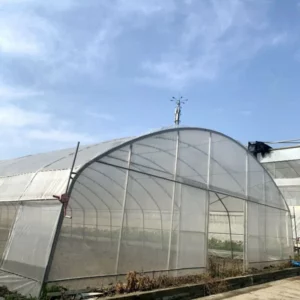Blackout systems in Plastic Film Single-Span Greenhouses can influence the regulation of humidity levels by controlling environmental conditions within the greenhouse.
Here are several ways blackout systems impact humidity regulation:
- Condensation Management:
- Blackout systems can play a role in managing condensation within the greenhouse. By controlling the amount of light and heat entering the structure, blackout curtains can help minimize temperature differentials that contribute to condensation on the greenhouse covering. This is particularly important during cooler periods when temperature variations can lead to moisture condensation.
- Ventilation Control:
- Blackout systems often work in conjunction with ventilation systems. During periods of high humidity, the blackout curtains can be adjusted to allow for increased ventilation. This helps in removing excess moisture from the greenhouse and maintaining optimal humidity levels.
- Preventing Excessive Moisture Accumulation:
- By limiting the amount of external light entering the greenhouse, blackout systems help regulate temperature, reducing the potential for excessive moisture accumulation. This is especially relevant during the nighttime blackout period when external humidity conditions may be higher.
- Temperature Regulation:
- The blackout system’s impact on temperature regulation indirectly influences humidity levels. By providing insulation during colder periods and controlling solar radiation during hotter periods, blackout systems contribute to a more stable temperature environment, which helps in maintaining balanced humidity.
- Humidity-Responsive Automation:
- Modern blackout systems may be integrated with environmental control systems that include humidity sensors. These sensors can trigger adjustments to the blackout curtains based on humidity levels. For example, China Plastic Film Single-Span Greenhouse suppliers if humidity rises above a set threshold, the blackout system may partially open to enhance ventilation and moisture removal.
- Optimizing Day-Night Transitions:
- The blackout system’s ability to create distinct day-night transitions influences humidity patterns. During the day, when blackout curtains are open, moisture levels may be influenced by external conditions. During the blackout period, moisture management can be more controlled, preventing abrupt changes in humidity.
- Minimizing Watering-Induced Humidity:
- Blackout systems can affect watering practices and subsequently impact humidity levels. The controlled environment provided by blackout systems allows for optimized watering schedules, preventing excessive moisture in the greenhouse that could elevate humidity.
- Fungal Disease Prevention:
- Humidity management is critical for preventing fungal diseases in plants. The blackout system’s ability to regulate environmental conditions contributes to creating an environment less conducive to fungal growth, providing a proactive approach to disease prevention.
- Condensation on Plant Surfaces:
- The control of temperature and humidity by blackout systems helps prevent condensation on plant surfaces. Excessive condensation on leaves can create conditions favorable for diseases, and blackout systems aid in mitigating this risk.
- Closed-Loop Environmental Control:
- Greenhouses with closed-loop environmental control systems, including blackout systems, can respond dynamically to changes in humidity. Integrated sensors and automation allow for real-time adjustments to maintain optimal humidity levels.
It’s important to note that while blackout systems can contribute to humidity regulation, their effectiveness depends on factors such as system design, integration with other environmental controls, and the specific requirements of the plants being cultivated. Regular monitoring and adjustments based on local climate conditions are essential for optimal humidity management in a Plastic Film Single-Span Greenhouse with a blackout system.
